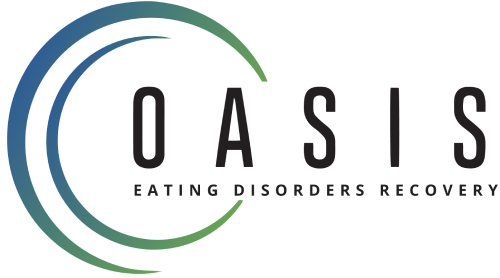Eating disorders such as anorexia nervosa, bulimia nervosa, binge eating disorder, and avoidant/restrictive food intake disorder (ARFID) are more than struggles with food—they are complex mental health conditions often linked to traumatic experiences, negative body image, and maladaptive beliefs. At Oasis Eating Recovery in Fresno, California, we recognize that recovery requires more than symptom management. It means addressing the emotional and psychological pain that drives disordered eating.
That’s why we offer Eye Movement Desensitization and Reprocessing (EMDR) therapy as part of our comprehensive treatment of eating disorders in Fresno. EMDR is a proven psychotherapy intervention that helps individuals process traumatic memories and shift harmful beliefs that fuel disordered eating behaviors. When integrated into treatment, EMDR can transform how clients relate to their bodies, food, and self-worth.
EMDR therapy, developed by psychologist Francine Shapiro, is a structured form of psychotherapy designed to help people heal from distressing experiences. Unlike traditional talk therapy, EMDR focuses on how traumatic memories are stored in the brain and body. By using bilateral stimulation (such as eye movements, taps, or tones), EMDR helps the brain reprocess stuck memories, reduce emotional distress, and form healthier associations.
The adaptive information processing (AIP) model guides EMDR, suggesting that traumatic events can disrupt normal memory storage. Instead of being fully processed, painful experiences remain “frozen,” continuing to trigger emotional and physical responses long after the event. EMDR works to “unlock” these memories, allowing for adaptive healing and resolution.

Research shows that many individuals with anorexia nervosa, bulimia nervosa, binge eating disorder, or restrictive food intake disorder have histories of trauma, negative body image, or unresolved emotional pain. These experiences often fuel harmful eating behaviors, creating cycles that are difficult to break.
EMDR addresses the root causes of eating disorders by:
By resolving trauma and painful memories, EMDR allows individuals to engage more fully in recovery and benefit from complementary therapies like cognitive behavioral therapy (CBT), nutrition counseling, and group therapy.
At Oasis Eating Recovery, EMDR is offered as part of a comprehensive treatment program for eating disorders. Our trained EMDR therapists follow established treatment guidelines to ensure safe, effective care tailored to each client’s needs.
A standard EMDR treatment plan follows eight structured phases:
In practice, EMDR sessions may last 60–90 minutes and are conducted by licensed clinicians experienced in treating both trauma and eating disorders. Clients engage in bilateral stimulation—often guided eye movements—while focusing on specific memories or beliefs. Over time, emotional reactivity decreases, and healthier, adaptive beliefs emerge.

Studies published in the Journal of EMDR Practice and Research and other psychiatry and behavioral health journals suggest that EMDR is effective in reducing symptoms of both trauma and eating disorders. Some case study findings and clinical reviews show that:
By targeting the overlap between trauma and eating disorders, EMDR provides a unique and effective treatment option within a comprehensive treatment plan.
At Oasis Eating Recovery, EMDR is not used in isolation—it is integrated into a holistic, evidence-based treatment program that addresses the full complexity of eating disorders. Alongside EMDR, clients participate in:
This integrated approach ensures that clients receive both targeted trauma care through EMDR and broader mental health treatment to support sustainable recovery.


EMDR is especially beneficial for individuals who:
Our EMDR-trained clinicians carefully assess whether EMDR is appropriate for each client, ensuring safety, readiness, and integration into broader care.
Many clients who come to Oasis Eating Recovery have histories of traumatic events, such as bullying, neglect, or abuse. These experiences can become embedded in memory, shaping how individuals view themselves and their bodies. Without intervention, these unresolved memories often manifest as disordered eating, purging, or restrictive food intake.
By using EMDR, our clinicians help clients reprocess these memories so they no longer fuel maladaptive beliefs or behaviors. This process not only reduces the intensity of trauma symptoms but also supports healthier eating behaviors, body image, and daily life functioning.
If you or a loved one is struggling with an eating disorder and the weight of unresolved trauma, Oasis Eating Recovery in Fresno, California, is here to help. Through EMDR therapy, evidence-based interventions, and compassionate care, we guide clients toward long-term recovery and renewed self-worth.
Call us today to learn more about our EMDR and eating disorder treatment programs near you and how our team can support your journey. Healing is possible—and it starts here.
We know that asking for help takes courage. Getting in touch is the first step. We’re here for you, no matter what. Once submitted, our admissions team will be in touch within 24 hours.
Or call us directly to get started: (559) 245-6203
Connect with our admissions team over the phone for a confidential conversation to understand your needs and goals.
Together, we’ll determine the level of care that best supports your recovery journey.
We create a comprehensive treatment plan to ensure continued healing and support with group therapy, nutrition, body image groups, individual/family sessions.
EMDR, or Eye Movement Desensitization and Reprocessing, is a form of psychotherapy that uses bilateral stimulation to help the brain reprocess traumatic memories. In the treatment of eating disorders, EMDR helps reduce negative body image, improve self-esteem, and address underlying trauma that fuels disordered eating.
Yes. EMDR has shown effectiveness for individuals with anorexia nervosa, bulimia nervosa, binge eating disorder, and restrictive food intake disorder. It is especially beneficial for those with histories of trauma or unresolved emotional pain.
In EMDR sessions, clients work with a trained therapist to recall distressing memories while engaging in bilateral stimulation such as guided eye movements. Over time, the memory becomes less emotionally charged, and healthier beliefs replace old, negative ones.
No. At Oasis, EMDR is integrated into a comprehensive treatment plan that also includes CBT, DBT, nutrition support, and family therapy. This ensures that both trauma and eating behaviors are treated for holistic recovery.
Our clinicians carefully assess each client’s history, symptoms, and readiness for EMDR. If trauma, negative body image, or unresolved emotional experiences are fueling disordered eating, EMDR may be recommended as part of a personalized care plan.

I will be back soon